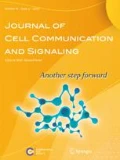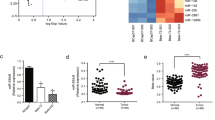Abstract
Nasopharyngeal carcinoma (NPC) is the most common malignant tumor of the head and neck region and is characterized by an increased risk of developing chemoresistance after treatment. The present study demonstrated that estrogen-related receptor α (ERRα) was upregulated in cisplatin- and fluorouracil-resistant NPC cells. In addition, ERRα knockdown or treatment of cells with the ERRα inverse agonist XCT-790 attenuated the chemoresistance of NPC cells. Mechanistically, the increased expression of ERRα in chemoresistant cells was associated with enhanced mRNA stability. Bioinformatics analysis for screening microRNAs (miRs) regulating the expression of ERRα revealed that miR-137 was downregulated in chemoresistant NPC cells. Additionally, transfection of cells with miR-137 mimics reduced ERRα mRNA stability and increased the chemosensitivity of NPC cells. Furthermore, ERRα knockdown reduced glucose consumption, and lactate and ATP production rates in chemoresistant cells. The aforementioned findings suggested that the miR-137/ERRα-mediated metabolic programming could be involved in the chemoresistance of NPC cells.







Similar content being viewed by others
Availability of data and material
All data and material are available.
References
Ablashi DV, Levine PH, Prasad U, Pearson GR (1983) Fourth international symposium on nasopharyngeal carcinoma application of field and laboratory studies to the control of NPC. Cancer Res 43:2375–2378
Ao A, Wang H, Kamarajugadda S, Lu J (2008) Involvement of estrogen-related receptors in transcriptional response to hypoxia and growth of solid tumors. Proc Natl Acad Sci USA 105:7821–7826
Ariazi EA, Clark GM, Mertz JE (2002) Estrogen-related receptor alpha and estrogen-related receptor gamma associate with unfavorable and favorable biomarkers, respectively, in human breast cancer. Cancer Res 62:6510–6518
Balaguer F, Link A, Lozano JJ, Cuatrecasas M, Nagasaka T, Boland CR, Goel A (2010) Epigenetic silencing of miR-137 is an early event in colorectal carcinogenesis. Cancer Res 70:6609–6618
Cao SM, Simons MJ, Qian CN (2011) The prevalence and prevention of nasopharyngeal carcinoma in China. Chin J Cancer 30:114–119
Chen QJ, Chen XB, Zhang MZ, Fan QX, Luo SX, Cao XG (2011) miR-137 Is frequently down-regulated in gastric cancer and is a negative regulator of Cdc42. Digest Dis Sci 56:2009–2016
Chen, P., Wang, H., Duan, Z., Zou, J. X., Chen, H., He, W., and Wang, J. (2014a). Estrogen-related receptor alpha confers methotrexate resistance via attenuation of reactive oxygen species production and P53 mediated apoptosis in osteosarcoma cells. Biomed Res Int 2014, 616025.
Chen P, Wang HB, Duan ZJ, Zou JX, Chen HW, He W, Wang JJ (2014b) Estrogen-related receptor alpha confers Methotrexate resistance via attenuation of reactive oxygen species production and p53 apoptosis pathway in osteosarcoma U2OS cells. J Bone Miner Res 29:S142–S142
Chen Y, Zhang K, Li Y, Guo R, Zhang K, Zhong G, He Q (2019a) Oestrogen-related receptor alpha mediates chemotherapy resistance of osteosarcoma cells via regulation of ABCB1. J Cell Mol Med 23:2115–2124
Chen Y, Zhao H, Li H, Feng X, Tang H, Zhang J, Fu B, Qiu C (2019b) LINC01234/MicroRNA-31-5p/MAGEA3 Axis Mediates the Proliferation and Chemoresistance of Hepatocellular Carcinoma Cells. Mol Ther Nucleic Acids 19:168–178
Chen Y, Zhou Y, Han F, Zhao Y, Tu M, Wang Y, Huang C, Fan S, Chen P, Yao X et al (2020) A novel miR-1291-ERRalpha-CPT1C axis modulates tumor cell proliferation, metabolism and tumorigenesis. Theranostics 10:7193–7210
Cheng SQ, Huang YX, Lou C, He YX, Zhang Y, Zhang QY (2019) FSTL1 enhances chemoresistance and maintains stemness in breast cancer cells via integrin beta 3/Wnt signaling under miR-137 regulation. Cancer Biol Ther 20:328–337
Deblois G, Smith HW, Tam IS, Gravel SP, Caron M, Savage P, Labbe DP, Begin LR, Tremblay ML, Park M et al (2016) ERRalpha mediates metabolic adaptations driving lapatinib resistance in breast cancer. Nat Commun 7:12156
Du FY, Yu L, Wu Y, Wang SQ, Yao J, Zheng XX, Xie SZ, Zhang SF, Lu XM, Liu Y, Chen W (2019) miR-137 alleviates doxorubicin resistance in breast cancer through inhibition of epithelial-mesenchymal transition by targeting DUSP4. Cell Death Dis. https://doi.org/10.1038/s41419-019-2164-2
Fradet A, Sorel H, Bouazza L, Goehrig D, Depalle B, Bellahcene A, Castronovo V, Follet H, Descotes F, Aubin JE et al (2011) Dual function of ERRalpha in breast cancer and bone metastasis formation: implication of VEGF and osteoprotegerin. Cancer Res 71:5728–5738
Fujimoto J, Sato E (2009) Clinical implication of estrogen-related receptor (ERR) expression in uterine endometrial cancers. J Steroid Biochem Mol Biol 116:71–75
Fujimoto J, Alam SM, Jahan I, Sato E, Sakaguchi H, Tamaya T (2007) Clinical implication of estrogen-related receptor (ERR) expression in ovarian cancers. J Steroid Biochem Mol Biol 104:301–304
Giguere V, Yang N, Segui P, Evans RM (1988) Identification of a new class of steroid hormone receptors. Nature 331:91–94
Han L, Liu B, Jiang L, Liu J, Han S (2016) MicroRNA-497 downregulation contributes to cell proliferation, migration, and invasion of estrogen receptor alpha negative breast cancer by targeting estrogen-related receptor alpha. Tumour Biol 37:13205–13214
Ho SN, Hunt HD, Horton RM, Pullen JK, Pease LR (1989) Site-directed mutagenesis by overlap extension using the polymerase chain reaction. Gene 77:51–59
Holohan C, Van Schaeybroeck S, Longley DB, Johnston PG (2013) Cancer drug resistance: an evolving paradigm. Nat Rev Cancer 13:714–726
Huang C, Wu M, Tang Y, Li X, Ouyang J, Xiao L, Li D, Li G (2009) NAG7 promotes human nasopharyngeal carcinoma invasion through inhibition of estrogen receptor alpha and up-regulation of JNK2/AP-1/MMP1 pathways. J Cell Physiol 221:394–401
Huang H, Li J, Shen J, Lin L, Wu X, Xiang S, Li Y, Xu Y, Zhao Q, Zhao Y et al (2020) Increased ABCC4 expression induced by ERRalpha leads to docetaxel resistance via efflux of docetaxel in prostate cancer. Front Oncol 10:1474
Ji HL, Song CC, Li YF, He JJ, Li YL, Zheng XL, Yang GS (2014) miR-125a inhibits porcine preadipocytes differentiation by targeting ERRalpha. Mol Cell Biochem 395:155–165
Kozaki KI, Imoto I, Mogi S, Omura K, Inazawa J (2008) Exploration of tumor-suppressive microRNAs silenced by DNA hypermethylation in oral cancer. Cancer Res 68:2094–2105
Lafargue A, Degorre C, Corre I, Alves-Guerra MC, Gaugler MH, Vallette F, Pecqueur C, Paris F (2017) Ionizing radiation induces long-term senescence in endothelial cells through mitochondrial respiratory complex II dysfunction and superoxide generation. Free Radical Biol Med 108:750–759
Lee AW, Ma BB, Ng WT, Chan AT (2015) Management of nasopharyngeal carcinoma: current practice and future perspective. J Clin Oncol 33:3356–3364
Lukey MJ, Katt WP, Cerione RA (2018) Targeting therapy resistance: when glutamine catabolism becomes essential. Cancer Cell 33:795–797
Luo J, Sladek R, Carrier J, Bader JA, Richard D, Giguere V (2003) Reduced fat mass in mice lacking orphan nuclear receptor estrogen-related receptor alpha. Mol Cell Biol 23:7947–7956
Martinez-Outschoorn UE, Lin Z, Ko YH, Goldberg AF, Flomenberg N, Wang C, Pavlides S, Pestell RG, Howell A, Sotgia F, Lisanti MP (2011) Understanding the metabolic basis of drug resistance: therapeutic induction of the Warburg effect kills cancer cells. Cell Cycle 10:2521–2528
Ranhotra HS (2015) Estrogen-related receptor alpha and cancer: axis of evil. J Recept Signal Transduct Res 35:505–508
Ranhotra HS (2018) The estrogen-related receptors in metabolism and cancer: newer insights. J Recept Signal Transduct Res 38:95–100
Stein RA, Gaillard S, McDonnell DP (2009) Estrogen-related receptor alpha induces the expression of vascular endothelial growth factor in breast cancer cells. J Steroid Biochem Mol Biol 114:106–112
Su TJ, Ku WH, Chen HY, Hsu YC, Hong QS, Chang GC, Yu SL, Chen JJW (2016) Oncogenic miR-137 contributes to cisplatin resistance via repressing CASP3 in lung adenocarcinoma. Am J Cancer Res 6:1317–1330
Thewes V, Simon R, Schroeter P, Schlotter M, Anzeneder T, Buttner R, Benes V, Sauter G, Burwinkel B, Nicholson RI et al (2015) Reprogramming of the ERR alpha and ER alpha target gene landscape triggers tamoxifen resistance in breast cancer. Cancer Res 75:720–731
Tribollet V, Barenton B, Kroiss A, Vincent S, Zhang L, Forcet C, Cerutti C, Perian S, Allioli N, Samarut J, Vanacker JM (2016) miR-135a inhibits the invasion of cancer cells via suppression of ERRalpha. Plos One 11:e0156445
Tsao SW, Yip YL, Tsang CM, Pang PS, Lau VM, Zhang G, Lo KW (2014) Etiological factors of nasopharyngeal carcinoma. Oral Oncol 50:330–338
Vishnoi A, Rani S (2017) MiRNA biogenesis and regulation of diseases: an overview. Methods Mol Biol 1509:1–10
Wicki A, Mandala M, Massi D, Taverna D, Tang HF, Hemmings BA, Xue GD (2016) Acquired resistance to clinical cancer therapy: a twist in physiological signaling. Physiol Rev 96:805–829
Wu F, Wang JJ, Wang YF, Kwok TT, Kong SK, Wong CW (2009) Estrogen-related receptor alpha (ERR alpha) inverse agonist XCT-790 induces cell death in chemotherapeutic resistant cancer cells. Chem-Biol Interact 181:236–242
Yao TT, Rao QX, Liu LY, Zheng CY, Xie QS, Liang JX, Lin ZQ (2013) Exploration of tumor-suppressive microRNAs silenced by DNA hypermethylation in cervical cancer. Virol J. https://doi.org/10.1186/1743-422X-10-175
Zhai S, Zhao L, Lin T, Wang W (2019) Downregulation of miR-33b promotes non-small cell lung cancer cell growth through reprogramming glucose metabolism miR-33b regulates non-small cell lung cancer cell growth. J Cell Biochem 120:6651–6660
Zhao Y, Li Y, Lou G, Zhao L, Xu Z, Zhang Y, He F (2012) MiR-137 targets estrogen-related receptor alpha and impairs the proliferative and migratory capacity of breast cancer cells. Plos One 7:e39102
Funding
This study was funded by the Science and Technology Foundation of Shenzhen (Grant No. JCYJ20180302144624391).
Author information
Authors and Affiliations
Corresponding author
Ethics declarations
Conflict of interest
The authors declare no conflict of interest.
Consent for publication
All authors give the consent for the publish of this study.
Additional information
Publisher's Note
Springer Nature remains neutral with regard to jurisdictional claims in published maps and institutional affiliations.
Rights and permissions
About this article
Cite this article
Liu, F., Gao, C., Wang, W. et al. miR-137/ERRα axis mediates chemoresistance of nasopharyngeal carcinoma cells. J. Cell Commun. Signal. 16, 103–113 (2022). https://doi.org/10.1007/s12079-021-00634-2
Received:
Accepted:
Published:
Issue Date:
DOI: https://doi.org/10.1007/s12079-021-00634-2




